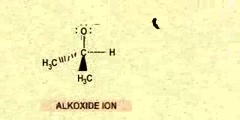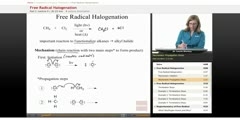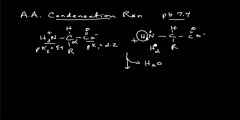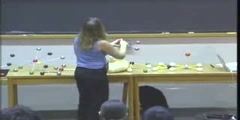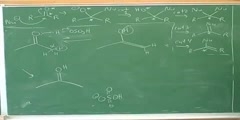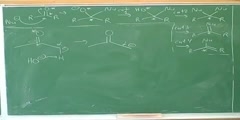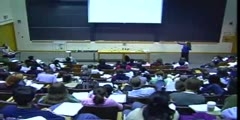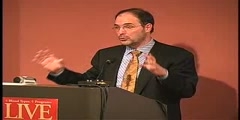Lec 22 - Radical and Type Theories (1832-1850)
"Lec 22 - Radical and Type Theories (1832-1850)" Freshman Organic Chemistry (CHEM 125) Work by Wöhler and Liebig on benzaldehyde inspired a general theory of organic chemistry focusing on so-called radicals, collections of atoms which appeared to behave as elements and persist unchanged through organic reactions. Liebig's French rival, Dumas, temporarily advocated radicals, but converted to the competing theory of types which could accommodate substitution reactions. These decades teach more about the psychology, sociology, and short-sightedness of leading chemists than about fundamental chemistry, but both theories survive in competing schemes of modern organic nomenclature. The HOMO-LUMO mechanism of addition to alkenes and the SOMO mechanism of free-radical chain reactions are introduced. 00:00 - Chapter 1. Benzaldehyde and the Focus on Radicals 12:52 - Chapter 2. Dumas's "Note on the Present State of Organic Chemistry" 21:39 - Chapter 3. The Mystery of the Chlorinated Candle 34:59 - Chapter 4. Further Development of the Law of Substitution and the Theory of Types 47:35 - Chapter 5. Kolbe and the First Free Methyl Radical Complete course materials are available at the Open Yale Courses website: http://open.yale.edu/courses This course was recorded in Fall 2008.
Video is embedded from external source so embedding is not available.
Video is embedded from external source so download is not available.
Channels: Chemistry (General)
Tags: Type Theory free radical addition reaction substitution reaction
Uploaded by: yalefreshorganic ( Send Message ) on 05-09-2012.
Duration: 49m 15s
Here is the next lecture for this course
Lec Last - Potential Energy Surfaces, Tra ...
47:44 | 5506 viewsNucleophilic Addition Reaction
00:32 | 6646 viewsFree Radical Halogenation
05:36 | 5611 viewsLec 44 - Free Radical Reactions
13:45 | 3038 viewsCondensation Reaction
08:59 | 9344 viewsLec 17 - Reaction Analogies and Carbonyl ...
41:44 | 2734 viewsChemical Science - The Shapes of Molecule ...
43:18 | 25215 viewsAldol condensation reaction (2)
08:51 | 7852 viewsAldol condensation reaction (1)
08:45 | 7640 viewsLec 27 - Introduction to Reaction Mechanisms
11:22 | 2433 viewsLec 23 - Valence Theory and Constitutiona ...
48:47 | 3009 viewsChemical Science -Transition Metals - Lec ...
50:39 | 17142 viewsSN1 reaction
00:12 | 9447 viewsDr. Peter D'Adamo: Blood Type, Diet and S ...
08:07 | 13015 viewsPhysical reaction to stress and polygraph
02:57 | 9071 viewsNo content is added to this lecture.
This video is a part of a lecture series from of Yale
Lecture list for this course
Lec 2 - Force Laws, Lewis Structures and Resonance
Lec 3 - Double Minima, Earnshaw's Theorem and Plum-Puddings
Lec 4 - Coping with Smallness and Scanning Probe Microscopy
Lec 6 - Seeing Bonds by Electron Difference Density
Lec 7 - Quantum Mechanical Kinetic Energy
Lec 8 - One-Dimensional Wave Functions
Lec 9 - Chladni Figures and One-Electron Atoms
Lec 10 - Reality and the Orbital Approximation
Lec 11 - Orbital Correction and Plum-Pudding Molecules
Lec 12 - Overlap and Atom-Pair Bonds
Lec 13 - Overlap and Energy-Match
Lec 14 - Checking Hybridization Theory with XH_3
Lec 15 - Chemical Reactivity: SOMO, HOMO, and LUMO
Lec 16 - Recognizing Functional Groups
Lec 17 - Reaction Analogies and Carbonyl Reactivity
Lec 18 - Amide, Carboxylic Acid and Alkyl Lithium
Lec 19 - Oxygen and the Chemical Revolution (Beginning to 1789)
Lec 20 - Rise of the Atomic Theory (1790-1805)
Lec 21 - Berzelius to Liebig and Wöhler (1805-1832)
Lec 23 - Valence Theory and Constitutional Structure (1858)
Lec 24 - Determining Chemical Structure by Isomer Counting (1869)
Lec 25 - Models in 3D Space (1869-1877); Optical Isomers
Lec 26 - Van't Hoff's Tetrahedral Carbon and Chirality
Lec 27 - Communicating Molecular Structure in Diagrams and Words
Lec 28 - Stereochemical Nomenclature; Racemization and Resolution
Lec 29 - Preparing Single Enantiomers and the Mechanism of Optical Rotation
Lec 30 - Esomeprazole as an Example of Drug Testing and Usage
Lec 31 - Preparing Single Enantiomers and Conformational Energy
Lec 32 - Stereotopicity and Baeyer Strain Theory
Lec 33 - Conformational Energy and Molecular Mechanics
Lec 34 - Sharpless Oxidation Catalysts and the Conformation of Cycloalkanes
Lec 35 - Understanding Molecular Structure and Energy through Standard Bonds
Lec 36 - Bond Energies, the Boltzmann Factor and Entropy
Lec Last - Potential Energy Surfaces, Transition State Theory and Reaction Mechanism


